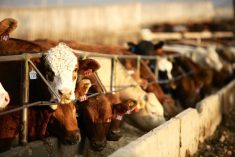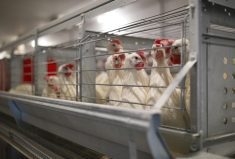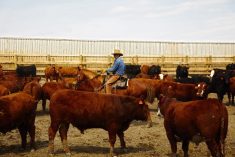A few years ago cattle in an American feedlot went down during transport to a packing plant and others developed severe lameness. This condition was eventually labelled fatigue cattle syndrome and became a huge animal welfare issue due to the appearance of severely lame, non-ambulatory cattle.
Initially beta-agonists were incriminated but numerous studies have essentially proven it was not due to this feed additive, but rather a combination of other factors. Coming out of this discovery were a number of preventive measures feedlot operators could use to prevent this condition from arising.
Read Also

Revamp started on Canada’s national pig code
The code that sets Canada’s standards care and handling of pigs is up for review, a process expected to be compete by 2028.
Dr. Dan Thomson of Kansas State University and a team of researchers in production animal medicine determined several stressors that lead to fatigue cattle syndrome (FCS). FCS has some characteristic symptoms but of course they can be confused with other syndromes such as acute laminitis due to grain overload, and selenium/vitamin E deficiencies. Symptoms of FCS include a strained pattern of breathing as well as very slow movements leading to non-ambulatory cattle. In severe cases there has been sloughing of the hooves.
Contributing factors to FCS are possibly preventable. The heat load definitely contributed, as the initial cases appeared in temperatures around 35 C. The specific findings may lead to specific recommendations in our upcoming Canadian transportation code revision and we need to be even more careful when handling transporting, and butchering cattle in the summer for these reasons. Depending on distance travelled or number of cattle moved and sorted perhaps a maximum temperature will be found that is safe.
We also know that hide colour has a lot to do with heat stress and that black-hided cattle are affected at lower temperatures. A good percentage of the cattle we see today in Western Canada are black hided.
I was privy to a very descriptive video showing heat stress in a pen of mainly black-hided cattle. While the majority of the cattle were in the shade of a porosity fence and breathing heavily, the red and white cattle were up at the feed bunk eating. Of the few cattle I have treated for heat stress over the years, all have been black hided. Cattle handling, the time spent loading, the distance travelled, and the stress during movement all contribute to FCS.
These may all seem like common-sense observations, and they are. Until this specific syndrome appeared there was no reason to suspect we had a problem.
The researchers also performed tests on the blood, looking at muscle enzyme levels to see if any damage was done. In affected cattle, the levels get very high. It is the same with downer cattle as they attempt to rise or calves with white muscle disease.
Dr. Thomson and his group found that aggressive handling produced the same muscle lactate levels as running a seven- or eight-minute mile or walking for about 20 minutes. We can all identify with this. If we run too far when we’re not used to it, our muscles can become extremely sore for a few days due to the buildup of lactic acid.
Feedlot cattle these days are getting bigger, and when they are in prime condition for butchering they are not athletic enough to be running around for any amount of time. In some large feedlots, the home pen may be more than a mile from the load-out area and that had a bearing on the incidence of FCS, so changes may need to be made it lot design. It may require staged moving or more load-out areas.
It will be nice to have parameters that are easily measurable and tied in with temperature.
FCS was even more clinical at the packing plants. Some common factors contributing to FCS at the plants were the time the cattle remained in the pens before slaughter and whether shade and cooling were available, particularly in areas with very hot climates. Cattle density in the pens was another factor. When holding pens get too crowded the cattle cannot properly dissipate heat.
Animal-handling practices and facilities were also looked at. Stress, exertion, and rough handling can often be reduced by better facilities or training of staff. The type of flooring was also looked at as some floor surfaces can cause injuries to the feet starting the process.
In the U.S., discovering the causes of FCS has led to training and monitoring protocol termed the “FCS Stewardship program.” The goal is to minimize or eliminate FCS by removing or reducing these risk factors across the industry.
Investigating all suspected cases should identify the areas that need improvement. Although the incidence of FCS may never have been as high in Canada as in the U.S. because of our more temperate climate, we still get very hot days in southern areas of the country in summer. So it makes sense to be aware of the potential ramifications of how we sort, process, load, and transport cattle. This is especially true with heavy market weight, black-hided cattle in the hot summer days.
This is also a good example of not jumping to conclusions when emerging diseases come out and thoroughly researching the cause. The feedlot industry was set back when some beta-agonists were prohibited from being fed as they were thought to be the cause. We must follow science and not jump to conclusions to allow the cattle industry to progress and remain sustainable.
















